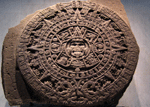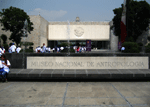Aztec Notes
1300 – 1519 (1521)
I. General
Strictly
speaking the Aztecs did not call themselves Aztecs, but rather Mexica.
(Throughout this class both terms, Aztec and Mexica, will be used to refer to
this dominant people of late pre-Columbian
II.
Language
III. Religion
and Cosmology
In general terms, the Aztecs discovered and promoted the
rhythms of nature for communal survival. Rituals aimed to instill fear and
trembling in the face of the dramas of nature. Think, for example, of the threats
of volcanic eruptions, earthquakes, and hurricanes. Aztec society was
theocratic, meaning that religious authorities ruled (theo = god; cratic = rule).
The religion was polytheistic (many gods), with sun worship at its
center. Religion, and hence society, was dominated by a priestly cast, and the
divinity of the emperor was unquestioned. Furthermore, Aztec cosmology,
society, and politics depended for their continuity on human sacrifice. (See
this course's definition of culture on the Definition of Humanities
page.) In other words, Aztecs thought that the gods must be strong and
satisfied for humans and society to survive, and for the gods' satisfaction
they had to be offered human hearts and blood. The best sacrifices were people
captured in the Aztecs' constant military conquests. A balance, therefore, was
achieved by a closed loop by which the state's prosperity depended on military
conquest and human sacrifice in order to face and overcome threatening nature—and
other threatening or invading peoples.
According to Aztec cosmology, the universe was divided in a double axis of horizontal and vertical. The horizontal axis featured the four cardinal points around a center with a god for each point and another god for the center. The vertical axis was divided with an Upper world and a Lower world. In the Upper world there were 13 heavens for the gods and below there were 9 levels of what the Western world calls hell, but in the Aztec concept there was no moral differentiation between the levels of hell. The underworld was for the dead and for women who died in childbirth. The Aztec compass pointed east just as the early medieval compass did. East is where the sun rises, and it represented the male principle. West is where the sun sets, and it is the female principle where the sun begins its fight through the underworld so that it can rise again the next morning.
Time progressed in 52-year cycles. Each cycle was known as a Sun Cycle. Notice that there are two approaches to the notion of "Suns" and sun cycles according to the Aztecs’ conception. According to one calculation, when the Spaniards arrived in Aztec territory, the Aztecs were in the early years of the Fourth Sun, which cycle was, of course, interrupted by the Spanish conquest in 1519-1521. According to the European calendar, the cycle of the Fourth Sun began in 1507 CE. (Incidentally, according to Chicano activists who understand the concept of Aztlán, contemporary Chicanos are living in the period of the Fifth Sun: See this course's cultural webpage for Aztlán). Counting backwards and using the European calendar, the period of the Third Sun B ran during the years 1455-1507 and Third Sun A ran from 1403-1455. The Second Sun existed in an undetermined, mythical, pre-empire period, and the First Sun existed in a mythical period two centuries earlier. In addition to the sun calendrical cycle, the Aztecs also had a lunar cycle of 13 months with 20 days each. (For Aztec drawings representing each of the 20 sacred days in the lunar months, see: => Aztec days.) The two cycles coincided on the first day of the next sun cycle after 52 solar years.
According to another calculation, when the Spaniards arrived at Tenochtitlán, Aztec civilization was already in the Fifth Sun (Nahui Ollin in Náhuatl). The god of the Fifth Sun was Tonatiuh. In the famous Aztec Calendar Stone (or Sun Stone), the face in the stone's center is Tonatiuh. Aztec mythology says that this last age, which was interrupted, and in which we are still living, will be destroyed by earthquakes. According to this calculation, the age of the Fifth Sun began in 1479, the last year of Axayácatl's reign and the first year of emperor Tízoc's reign. The previous "sun" did not specifically cover, however, a 52-year period. Even so, the period of the Fifth Sun was defined as the Sun of full human civilization. In this mythological system of Aztec "Suns," the first Sun was created when the gods threw themselves into a fire in Teotihuacán. This First Sun was immobile. The sacrifice of more gods in this first sacred fire set the sun in motion. The order of the four mythological sun periods varies according to different authorities and traditions. According to one tradition, the Third Sun was the Sun of the Rain of Fire, which fire consisted metaphorically as a light volcanic rain. In reality, the myth of the Third Sun may have been referring to the eruption of the Xitle volcano (see: => Cuicuilco), which triggered the emigration of its survivors to Teotihuacán. In any case, the order of the Sun periods according to the famous Aztec Calendar Stone (Piedra del Sol) now housed in the Museo Nacional de Antropología in Mexico City is as follows: First Sun (Wind Sun; Quetzalcóatl was the god of wind); Second Sun (Rain Sun, whose god was Tláloc); Third Sun (Water Sun); Fourth Sun (Jaguar Sun). According to Aztec mythology (cosmology and religion), each Sun was destroyed and the entire cosmos and Aztec civilization would have ended had not massive blood sacrifices been made on the night before the next Sun was to appear, first by the gods, then by the emperors and priests, and finally, by captives, slaves, and virgins.
From a pre-Columbian, Aztec perspective, the end-of-epoch ritual was a model of symbolic beauty. Aztec priests ascended the Hill of the Star (i.e., Venus, the morning star) on the extinct volcano of Cuicuilco (see the Cuicuilco pages). The sign for the world of a new epoch to begin was when the star reached the center of the night sky (i.e., the heavens). Then a new fire was set ablaze in the chest of a freshly killed sacrificial victim. Runners lit their torches in this new fire and ran to spread the light from these torches in houses, temples, towns, etc. Joy among the people increased, it is said, whereupon personal bloodletting and the immolation of captives was carried out in many places throughout Aztec-controlled lands.
Some of the main Aztec gods are:
- Quetzalcóatl (name means “feathered serpent;” god of wind, creation, fertility, and patron deity of the Aztec priesthood): For an Aztec codex illustration of the Quetzalcóatl facing Tezcatlipoca, see: => Codex Borbonicus. For his legendary birthplace, see: => Tepoztlán. For his stay at Tula, see: => Tula. For his stay at Chichén Itzá, see: => Chichén Itzá. For his relationship with Hernán Cortés, see: => Cortés Chronology.
- Tláloc (god of rain and corn; parallel to the Maya god Chaac)
- Huitzilopochtli (name means “hummingbird of the south;” original Mexica war god and god of sacrifice and the sun; patron deity of the Mexica/Aztecs)
- Tonatiuh (name means: “he goes shining forth;” sun god)
- Tezcatlipoca (name means “smoking mirror;” war god and god of total power; Tezcatlipoca, who was transformed into the first sun, is also the patron deity of Mexica/Aztec kings; this god ran Quetzalcóatl out of Toltec Tula); see: => Tezcatlipoca
- Coatlicue (the demi-goddess mother of Huitzilopochtli, the goddess of creation and destruction, birth and death, beginning and end, light and darkness)
- Coyolxauhqui (demi-goddess of the moon and Huitzilopochti’s brother; she and her other siblings tried unsuccessfully to kill her mother Coatlicue and her brother).
Note on the effigy of Huitzilopochtli recreated annually in the seventh phase of the temple dedicated to this god in the Templo Mayor in Tenochtitlán. It was made from amaranth seeds and glued together with honey and the blood from human sacrifices made in front of the statue. Inside the effigy were bags containing jade, bones, and amulets, the purpose of which, according to the Aztecs, was to provide sustenance for the god. The effigy was reconstructed each year and was dressed in rich clothing; its head was covered in a mask made of gold. When the annual ritual celebration dedicated to Huitzilopochtli ended, the effigy was torn apart and thrown down the pyramid for the worshippers to eat.
One of the most dramatic artifacts of Aztec cosmology is the famous Calendar Stone (el calendario azteca). In fact and more accurately, it is now known as the Piedra del Sol (Sun Stone). This polychrome stone disk is as intricately carved as an small jade carving, but, instead, it is monumentally huge. The stone was painted with 20 different colors. At its center is the Sun (a god: Tonatiuh). Flanking the face of Tonatiuh are four more or less square boxes indicating the four suns. In a circle around the four boxes are symbols of the 20 named days of the 20 days in the 13 months of the Mesoamerican lunar calendar. Farther out from the day symbols there are symbols of the heavens and the stars. The outer circle shows two fire serpents meeting at the base of the stone disk. For pictures of the Calendar Stone and more commentary, click on the following image:
IV. The great temple (Templo
Mayor) in myth and history
The myth and the history of the founding of Tenochtitlán overlap. At the
heart of the Aztec capital is the great temple (el Templo Mayor), which, in effect, was the city's
combined power center of their religion and their government. According to
objective history, the Mexicas migrated from a place either near or far to the
northwest of the present-day Mexico City to a place they called Coatepec (the
serpent hill), which was reputed to be the birthplace of Huitzilopochtli. Here
they settled. The Mexica band belonged to a larger tribe called the Huitznahua.
The Mexica band was led by a human chieftain, Huitzilopochtli. The Huitznahuas
were led by a woman warrior named Coyolxauhqui, but, led by her, the
Huitznahuas attacked their chieftain. In the internecine fighting
Huitzilopochtli defeated the Huitznahuas and he killed and decapitated
Coyolxauhqui. Huitzilopochtli had the hearts of the defeated Huitznahuas cut
out.
On the basis of this legendary/historical
event, it appears, the myth of the Aztec war god Huitzilopochtli was elaborated
over time. In the Aztec origins myth, the name of the historical leader
Coyolxauhqui was the daughter of a woman named Coatlicue (also, see below).
According to the myth, Coatlicue, who had already given birth to 400
"Southerners" became pregnant by means of feathers that fell on her
from the sky and that she hid in her bosom. The son that she bore from this
miraculous conception was Huitzilopochtli. Seeing that her mother Coatlicue was
dishonored, Coyolxauhqui conspired with the 400 children to kill their mother.
One of the 400 alerted Huitzilopochtli about the conspiracy. The boy dressed
for battle: a shield covered with eagle feathers, a blue dart weapon, face
painted with diagonal stripes, earplugs, feather-covered sandals, and blue
paint on his legs and arms. One of his companions killed and decapitated
Coyolxauhqui on Coatepec hill, and her body was thrown to the bottom of the
southern side of the hill—which mythical event was recreated in the Templo
Mayor site. (For the giant stone disk of Coyolxauhqui, see: => Museo del Templo
Mayor #3). Meanwhile, Huitzilopochtli alone annihilated the
400. Huitzilopochtli's identification with the eagle makes him a sun symbol.
The defeated woman Coyolxauhqui makes her a moon symbol.
When the Mexicas settled on the
V. Aztec history
In the European year of 1325 CE, the Mexica tribe
discovered and settled on an island in Lake Texcoco, in the middle of the Valle
de Anáhuac, where the present-day capital of México, the Distrito Federal
(D.F.), is located. This tribe had arrived in the Valle de Anáhuac about
twenty-five years earlier. The Mexica/Tenochca called their new city-state
Tenochtitlán (in Nahuatl, "city of Tenochcas"). The war god
Huitzilopochtli was their principal deity. According to their oral history,
Huitzilopochtli told them in a prophecy to leave their original island
In the Aztec historical period, the emperor (tlatoani: the one who speaks, the maximum Mexica ruler) Motecuhzoma Ilhuicamina (Moctezuma I: 1440-1469) extended the Mexica's region of power. The following Aztec emperor, Axayácatl (1469-1479) extended the power area even more, and he stimulated Aztec religious arts fully. During Axayácatl's reign the Aztec Calendar (Sun) Stone was created.
During the time of Axayácatl, Nezahualcóyotl (died 1472), the king of a
rival kingdom on the edge of
Following the Aztec emperor Axayácatl was emperor Tizoc (1479-1486). He
supervised the construction of the great pyramid in the heart of Tenochtitlán
with a double temple on its top tier. This temple was dedicated to the war god
Huitzilopochtli and the rain god Tláloc. In addition, during his reign the
famous sacrificial stone of Tízoc was carved. After Tízoc comes Ahuitzotl
(1486-1503), who led Aztec conquests down to
Here is a list of the known Aztec emperors, with Common Era (C.E.) dates and
Aztec dates at the
Acamapichtli 1372-1391
Huitzilihuitl 1391-1415
Chimalpopoca 1415-1426
Itzcóatl 1426-1440 (4 Reed, 1431
C.E.)
Moctezuma I 1440-1468 (1 Rabbit, 1454
C.E.)
Axayácatl 1468-1481 (3 House, 1469
C.E.)
Tízoc 1481-1486
Ahuizotl 1486-1502
Moctezuma II 1502-1520
Cuitláhuac 8 days in 1520; Moctezuma
II’s brother
Cuauhtémoc 1520-1521 (Ahuitzotl’s son
and Moctezuma’s half brother)
V. Aztec Society and Economy
The Aztec capital was called Tenochtitlán, located in Lake Texcoco, which now is covered
by most of
The tenochcas lived by a lake for protection, isolation, survival,
and power. Floating gardens (the famous chinampas) were created to
produce food and flowers. As the population expanded, as the empire grew more
powerful and successful, the island-city expanded into the lake, where housing
neighborhoods were constructed. Bridges and aqueducts were maintained in
excellent condition to the mainland. For example, two channels were maintained
to the hilly area at
VI. Aztec Arts
Aztec art contains the following distinctive
characteristics: (1) a wide range from austere realism to total abstraction;
(2) careful proportion in all arts and crafts; (3) non-secular themes and
images; (4) natural elements that complement religious concepts (i.e., there is
no European emotionalism or individualism); and (5) synthesis and appropriation
of art of conquered peoples. For example, from the Toltecs the Aztecs got
images of eagles and devoured hearts and walls of serpents and skulls. In very
general terms, artistic features rather unique to the Aztecs are obsidian
knives, rock-crystal skulls (for rituals and for art), and jade statues (especially
of Xólotl, Quetzalcóatl's brother, the god of lightening and death often
depicted as a skeleton, a man with a dog's head, or a monstrous animal with
reversed feet; also, Xólotl was the god of the ballgame). Variety was added to
distinctively Aztec art by baroque complexity imported from Monte Albán
(archeological site in
One of the finest achievement the Aztecs made in the
arts was in the literary genre of poetry. The Aztecs wrote in their language,
Náhuatl. Since their civilization was at its peak of development and
achievement when the Spanish discoverers and conquistadors arrived in
Museums and private collectors all over the world have collections of Aztec art. However, the most important collections of such art is found in the Museo Nacional de Antropología de México (MNA) —one of the greatest museums in the world—in México, D.F. The research arm of the MNA is the Instituto Nacional de Antropología e Historia (INAH). Click on the following initials for their official website: MNA.INAH. For the professor-photographer's photo tour of this museum, click on the following image:
For a photo tour of highlights of Aztec art in the Museo Nacional de Antropología click on the following image:





